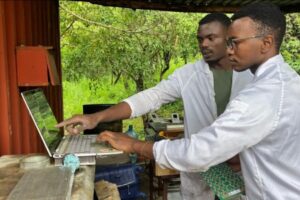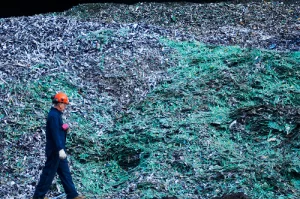Nigeria: Osun in the Mud As Mining Greed Intensifies
By Taiwo-Hassan Adebayo
As communities get greedy, the government fails to enforce regulations to ensure those they licensed and illegal miners do not destroy the environment, water, and people’s cultural assets while smiling to the bank.
Osun State, Nigeria – Ragged and his skin stained brown, Abu Awwalu emerged with a shovel and axe and climbed over clods of earth that have mounted after weeks of pitting. It was twilight and Mr Awwalu had been digging since morning and creating hollow mine shafts in search of gold in this jungle near Idoko Ijesha, Obokun Local Government Area.
Fortunate to hit gold, Mr Awwalu went to the Opo River meandering through Ijeshaland to wash the raw mineral. He not only blocked the natural flow of the water, but he was also polluting the water. Having no knowledge of responsible mining, he left the tailings – the residue after washing the raw mineral – and the wastewater untreated and let them flow into the waterway.
Mr Awwalu said he is one of the thousands of economic migrants forming a brimming presence in otherwise slumbering Ijesha gold-rich communities like Idoko, Ibala, Itagunmodi, Iponda, Araromi, and urban neighbourhoods in Ilesha, the Ijesha heartland.
Mr Awwalu and others had moved southwards, in droves, following the unrelenting violence of terrorist outlaws and the military countermeasures in Zamfara State, northwestern Nigeria. The Zamfara conflict as well as the ban on gold mining, once theorised as fueling banditry, in the state had forced open a search for new sites.
Ijesha area of Osun State in the South-west then became a new destination. Though long known to have vast gold deposits and some mining minimally happening, residents said “it was only recently” that mining activities became intense and widespread, happening both in urban areas – for example, Arimoro and Isale General areas of Ilesha – and rural communities across Obokun, Atakunmosa East, Atakunmosa West, and Oriade local governments.
“These (rural) areas have practically been taken over by illegal miners,” Tony Adejuwon said. His not-for-profit Urban Alert has advocated responsible mining and protection of the environment and water resources in Osun State.
“A lot of them, about 20 thousand, came from Zamfara en masse,” said the Deputy Chief of Staff to Governor Gboyega Oyetola, Adeyanju Binuyo, who oversees mining activities in the state. Mr Binuyo corroborated local narratives that the widespread mining activities, commonly illegal and unregulated, in the Ijesha area as well as Ile-Ife started recently, following the crisis in Zamfara.
The economic migrants like Mr Awwalu – who Mr Binuyo described as ‘scavengers’ – are mostly labourers. They use crude tools for extraction, in a chain of artisanal mining that is almost always unlicensed. They either work for someone who has invested in acquiring access to a mining site from local landlords or work independently to extract raw gold for off-takers or middlemen.
“Usually, a miner will buy the land having gold from the community and bring the Hausa to work on it but sometimes some of them also enter the jungle to mine for themselves and sell to the miners or gold traders after weighing the gold,” said Alaba Aluko, an Ilesha resident with the local knowledge of the mining activities in the area.
And even where miners claim they are licensed by the government, like the Arimoro, Ilesha small scale and artisanal site of Biggie (as the miner wants to be identified) or the industrial-scale sites using heavy pieces of machinery in Iponda or Isale General, there is rarely any demonstration of responsibility for the environment and the society. This is in contravention of Nigeria’s 2007 mining law and 2011 regulations.
The Ilesha gold belt is worth about five billion dollars, according to research by a professor, Olugbenga Okunlola, who is the president of the Geological Society of Africa. However, except for profiteering miners, rent-seeking community leaders, and compromised government officials, who fail to enforce regulatory standards, the search for gold is increasingly leaving devastating impacts.
“At the end of the day, what benefits accrue to the people from mining?” Femi ‘Fad’ Fadurotimi, a farmer and pastor, queried rather rhetorically, as he watched an excavator in action, dumping mining wastes into the Opo River waterway near his farm in Iponda.
“This (mining) is of no benefit to the state in any way,” said Mr Binuyo. “It ends up polluting the land, it ends up degrading the land. It affects farming. Mining is a very transient activity. After some time it winds up and makes the land impossible to farm on.”
Against the requirement of Nigeria’s 2011 mining regulations for reclamation and restoration of mine land and safe disposal of wastes, in the mining communities visited, mounts of clods fencing pits and ponds of contaminated water dot the landscape.
This offers a visual indication of the devastation mining is causing in the area, particularly to the water resource and by extension farming, livelihoods, and cultural assets like River Osun.
Osun River in the mud, endangered
Mr Biggie, portly and neat, operates a small-scale mining site in the Arimoro area of Ilesha, with artisans like Mr Awwalu, using crude tools, as his labourers. The site sits on a side of the Opo River, which is dammed to be used for washing raw gold. In that process, the course of the water is disturbed and polluted with clods and tailings.
“There is no way we can do mining without water because we have to wash and that is the reason our activities are by the side of the river,” said Mr Biggie. “We have to dam the water for that purpose. There is nothing else we can do. Even those that mine on the hills far from the water will still have to bring the mineral here (to the river).”
He showed no knowledge of “proper treatment” of wastewater and tailings before they are disposed of to prevent air and water contamination as required by the country’s mining regulations
Polluted due to mining industry activity, the Opo River forms a confluence around Iponda Ijesha in Obokun LGA with River Osun, which takes its course from Igede Ekiti in Ekiti State. River Osun is a cultural and spiritual asset with the Sacred Groove in Osogbo, the capital of Osun State, where the international Osun Osogbo Festival takes place every year.
Osun is a branch of African Traditional Religion and adherents believe in the supernatural powers of the water, which they commonly call ‘concoction’.
“In August every year, devotees from across the world come together for the celebration of the Osun Osogbo Festival and there are prayers and appeasements in that place,” said Funmi Ajayi, a senior technical officer at the National Commission for Museums and Monuments, which manages the grove. “We so much believe in the sacredness of Osun. It is powerful. It is medicinal. It has healing powers.”
Apart from during the annual festival, people daily visit the grove, a UNESCO World Heritage site, to seek spiritual solutions to their problems, including infertility and ill luck.
Sitting on a 75-hectare dense forest and serving as the home of the Osun, the goddess of fertility in Yoruba mythology, the grove and the concoction – as the meandering river is called – hosts the first palace of the Ataoja of Osogbo, shrines, sanctuaries, and symbolic sculptures.
“The sacred grove, which is now seen as a symbol of identity for all Yoruba people, is probably the last in Yoruba culture. It testifies to the once widespread practise of establishing sacred groves outside all settlements,” says UNESCO, which designated the grove a World Heritage Centre in 2005.
However, with the mining activities happening at its upper course in Ijeshaland, where it forms a confluence with Opo River, the natural beauty of River Osun is deteriorating, now turning mud-brown.
“Before now, you could clearly see your legs if you dipped them into the concoction (the river); it was clear and clean,” said Moji Osunkeye, an Iworo Osun (a resident Osun devotee). “Osun changed colour gradually about three years ago.”
Already, devotees are contending with the challenge of convincing visitors that the powers of Osun are intact despite turning “erofo” – mud water. “When people come and see the colour, they want to turn back before we now tell them that the spiritual and medicinal value of Osun remains undamaged despite the pollution,” said Osunyemi Efunsola, the Iya Busoyin.
And the aquatic lives – the fishes the devotees regard as the children of Osun – are apparently affected. “We now do not see fishes appear anymore,” Ms Efunsola said. “Before, when we offered appeasements to Osun, the fishes would be seen.”
Citing laboratory test results, Osogbo-based not-for-profit Urban Alert said dangerous chemicals such as mercury, lead and cyanide are discharged into the river due to the mining activities, thereby endangering human and aquatic lives.
“We collected samples from four points of the Osun River and tests were carried out in collaboration with senior researchers from the Obafemi Awolowo University Ile-Ife. Analysis shows the contamination of the water and presence of mercury, lead and cyanide,” Mr Adejuwon, the team lead of Urban Alert, said.
“We used Geographical Information System to link the contamination with the mining activities in Ijesha axis. Many tributaries of Osun in the area with scores of communities depending on them have also been contaminated,” he added.
The deterioration of Osun due to the Ijesha mining activities is a breach of Nigeria’s mining regulations, which require that effluent must be prevented from flowing into cultural and spiritual sanctuaries to protect their sacredness and value.
Osun Osogbo has not been included on the UNESCO’s List of World Heritage in Danger. However, its deterioration due to mining could make it a candidate.
According to UNESCO, deterioration of the “severe natural beauty or scientific value” of a heritage site due to mining, among other human and industrial activities, is a criterion for putting a site on the List of World Heritage in Danger.
‘Nigerians visit Saudi, Israel for spiritual assets’
Among the Osun devotees, awareness of the impact of mining on Osun is solid, and they have petitioned the state government, seeking actions against the irresponsible miners.
“In Saudi Arabia and Israel, there are spiritual properties and they do not allow them to deteriorate or be desecrated. So, Nigerians go to those places. Osun is our own heritage. Why are we allowing it to be destroyed?” queried Ms Efunsola.
“Government should ensure that money from mining does not cause further deterioration of Osun. They should do something to control these miners.”
She said no action has followed the petition to the state government.
Osun is extremely important to the government and we are working to reverse this trend,” said Mr Binuyo, the governor’s senior aide.
Although mining is federally controlled as Nigeria’s law provides, Mr Binuyo said the state government created a joint task force of security agencies to patrol gold mining communities and arrest illegal miners.
He added that the state’s Mineral Regulation and Environmental Management Committee (MIRENCO) plays an intelligence-gathering role by sharing telephone numbers with local communities to report sightings of illegal miners.
“Once they report, we flag it and escalate it to the federal government,” Mr Binuyo said.
However, these efforts appear to amount to nothing on the ground. Illegal mining goes on, and so is the lawless handling of mining wastes and degradation of the environment by licensed miners.
The federal government, which has the constitutional responsibility for mining, is far removed from the communities where mining takes place, thereby hindering the capacity to enforce regulatory standards.
Mr Adejuwon said the federal government is “failing in its responsibility by allowing people they licensed and those they do not license to cause environmental damage, destroy watercourses, and endanger host communities and the cultural property like Osun Osogbo against the provisions of the 2007 Mineral and Mining Act.
“That is why we are we are now. They allow people to smile to the bank while destroying the environment, mining without respect for the watercourses,” he added.
The Director of Mines Environmental Compliance at the Federal Ministry of Mines and Steel, Vivian Njoku, did not comment on this report. She did not reply to our message nor did she return calls after we described our findings and shared our questions with her.
However, Mr Adejuwon insisted that the state government had developed a “lukewarm attitude towards enforcing environmental standards and protecting its people as well as the Osun Osogbo cultural property.” He said the state has to be more forceful about addressing the consequential effects of irresponsible mining to avoid a repeat of the Zamfara lead crisis.
“And we are almost getting there,” he lamented.
And the police, though with stations and personnel at the grassroots, are more invested in either protecting mining sites, especially those owned by the Chinese, or routinely extorting road users than helping to combat illegal miners, who conspicuously operate.
In one case, on the road between Ilesha and Itagunmodi, while unregulated mining activities happen, police officers were observed extorting commercial motorcyclists.
“What they do is to collect money from okada riders without ever arresting the illegal miners, who they see every time. They collect bribes and allow the movement of illegal miners,” said Mr Aluko, the Ilesha resident.
‘Communities to blame’
Watching an excavator in action from a bridge across the Opo River at Iponda, the farmer and pastor, Mr Fadurotimi, said mining is posing difficulties to farmers and communities.
“In a few years, this place will not be passable because if this mining trend continues, the waterway will be blocked. And if water cannot flow, the whole area will be flooded when it rains and even farmers may be swept away when they don’t suspect,” Mr Fadurotimi said.
“Due to mining, we are no longer able to use water for farming. That is the first implication. Water no longer flows freely and we have to go bring tankers from town to wet our farms.”
Asked if farmers are compensated by miners, he said, “Landowners are the ones that collect money from the miners. The miners may not pay a farmer more than N20,000 and it is only when they want to pay.
“I had cocoa and banana farms. One day, I got there and I met miners. I asked them what they were doing, they said the landowners had sold the land to them. I said okay pay me for my farms. How much did they pay? It was with pleas and pressure that I was able to get N20,000.”
He added that the water body had changed colour due to mining. “This is not water anymore. This is erofo (mud water). It used to be clean. If we want to spray our farms, we have to bring water from town.”
Another farmer between Araromi and Itagunmodi, Ola Waheed, said mining has devastated water sources but blamed landowners and community leaders for their “short-sightedness.”
“The landowners offer their land to illegal miners and sabotage their future and main occupation of farming because of money,” Mr Waheed said. “In Araromi, my village, villagers are suffering and palm oil farmers have to travel far to get water to wash their kernels to extract palm oil.”
Depending on the size of the land, they collect millions and some collect a hundred thousand. And if you are a mere farmer, you could be given just N20,000 so far the owners of the land have sold it.”
Community leaders would not admit the problem of land and water degradation but that, as residents and farmers said, is due to their complicity.
“We do not have any problem with water,” said the Sajiko of Araromi, Ogundoyin Agbede. “Miners know their limit and their mining does not affect our water and farms.”
Residents, who would not want to be identified for fear of being victimised in the community, debunked Mr Agbede’s claim.
Mr Binuyo, the Deputy Chief of Staff to the governor, said local communities need environmental education to appreciate the devastating impacts of unregulated mining which they commonly welcome.
“Communities invite these illegal miners for pecuniary rewards to take over their farmlands to mine In Ile-Ife axis, where a chief left his palace for illegal miners to live and get a heavy pecuniary reward,” said Mr Binuyo.
“The problem is that they do not have the technical capacity to mine. Mining involves a process. If you treat the wastewater before discharging it into the waterway, there won’t be any problem as far as water is concerned.”
However, it is not all miners in the area that are illegal miners. There are about 160 mining titles, according to Mr Binuyo. Yet, due to weak regulatory capacity and the role of compromised local landowners, the licensed miners also do not practice in a way that protects the environment.
“The land has now become impossible to use for farming but it also means contamination of the water,” said Mr Aluko.
“The problem has happened already,” Mr Adejuwon said, arguing that stopping miners is not the whole issue. He said the degraded land and water have to be rehabilitated and restored first.
“After that, we can then start talking about enforcing environmental and mineral mining standards,” he said.
Share this content:














